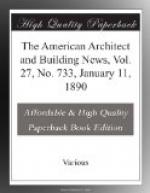These facts and figures regarding the Slater Memorial Museum are valuable only so far as they go. They show that the first problem of a museum—to interest the public at large—has there been solved successfully. More than that is not to be looked for yet. The ultimate good which the institution will accomplish can be but imperfectly manifested in one generation. It is from the children now growing up, from their children and their children’s children, that the deeper results are to be expected. As the beginning has been made, we can afford to wait for the rest, which will come in good time. The lesson to be learned from it now is, that such collections are needed, that they are appreciated not by a few but by many, and that, so far as the cost is concerned, they are within the reach of every well-settled community.—New York Evening Post.
* * * * *
SANITARY ENTOMBMENT: THE IDEAL DISPOSITION OF THE DEAD.[4]
[Illustration]
In this country, partly because there were few places of large population, and partly because it was an early and general tendency to use cemeteries rather than churches, and the grounds adjacent to them, the evils of earth-burial did not manifest themselves so soon or in so marked a manner as in the Old World. But there were instances enough to convince the most incredulous that a radical change must be made. Dr. Ackerly, writing in 1822, thus describes the condition of the burial-ground connected with Trinity Church, New York, forty years before: “During the Revolutionary War this ground emitted pestilential vapors, the recollection of which is not obliterated from the memory of a number of living witnesses.” In the same year, the Commercial Advertiser published an article in reference to the present evils of earth-burial at the same place, in which it was said: “It will be remembered that the graveyard, being above the streets on the west, and encompassed by a massive stone wall, and the east side being on a level with Broadway, it results that this body of earth, the surface of which has no declivity to carry off the rain, thus becomes a great reservoir of contaminating fluids suspended above the adjacent streets. In proof of this, it is stated that, in a house in Thames Street, springs of water pouring in from that ground occasioned the removal of the tenants on account of their exceeding fetidness.” At a later date, Dr. Elisha Harris brought this telling indictment against the same place of interment: “Trinity churchyard has been the centre of a very fatal prevalence of cholera whenever the disease has occurred as an endemic near or within a quarter of a mile of it. Trinity Place, west of it, Rector Street, on its border, the streets west of Rector and the occupants of the neighboring offices and commercial houses have suffered severely at each visitation of the pest from 1832 to 1854.” It seems hardly necessary to add that the foregoing statements are not intended to make the impression that there was a worse condition at the churchyard named than at any other....




